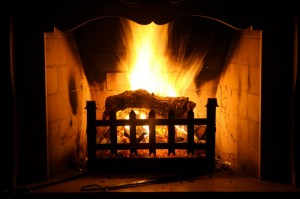Your fireplace adds warmth and comfort to your home and helps to lower your heating bills during the cold winter months. However, your fireplace also can pose a danger to your home and your family — Fireplaces and chimneys are responsible for 42 percent of all home fires. There are steps you can take to keep your home and your family safe from the risk of a fireplace or chimney fire.

- Have your fireplace cleaned and inspected annually. The number one thing you can do to keep your home and family safe from a chimney- or fireplace-sparked home fire is to have your fireplace and chimney cleaned and inspected each year by a certified chimney sweep. Clean chimney’s typically don’t catch fire, and an inspection of the chimney and fireplace ensures that all components are in good repair and safe working order.
- Keep the area in front of the fireplace free of flammable materials, including rugs, pillows, decorations or papers. Make sure that any decorations on the mantle are secure and don’t hang over the fireplace opening where they could be ignited.
- Always use a fireplace screen to ensure that sparks remain inside the fireplace and that flammable materials don’t accidentally make their way into the fireplace.
- Only burn the fuel intended for your fireplace. Never burn wrapping paper, cardboard, charcoal, garbage or other unintended materials in your fireplace. Don’t use a fire starter or other accelerant in your fireplace.
- Install a cap at the top of your chimney to make sure that animals or other debris can’t enter into and block your chimney.
- Burn seasoned firewood. Only burn firewood that has been properly dried and seasoned. Wet firewood burns cooler and emits more smoke, causing dangerous and flammable creosote to build up in your chimney more quickly. If you’re using manufactured logs, make sure you follow the manufacturer’s instructions.
- Leave the damper open until all embers have finished burning to prevent dangerous gases, like carbon monoxide, from building up inside your home.
- If your fireplace has glass doors, make sure they are fully open when a fire is burning to ensure proper airflow.
- Store ash in an air-tight metal container when you remove it from your fireplace. Wet the wood ash prior to attaching the metal lid. Never store the metal ash container on your deck, in your garage, or in any location that may allow the heat inside to transfer from the container to nearby flammable items. Place the container on a non combustible surface such as stone, concrete brick or slate away from the home.
- Never leave a fire unattended. Make sure the fire has burned out completely before you go to bed or leave the house.
- Install smoke detectors and carbon monoxide detectors on each floor of your home, particularly near sleeping areas. Check and change the batteries of your smoke and carbon monoxide detectors regularly.
- Keep a fire extinguisher on hand. Make sure you have a working fire extinguisher in your home. Make sure you know where it is and how to use it.
If your fireplace is due for its annual inspection and cleaning, call the experts at Clean Sweep of Anne Arundel County. In addition to making sure your fireplace and chimney are ready for your winter fires, we can advise you on safe fireplace practices.
